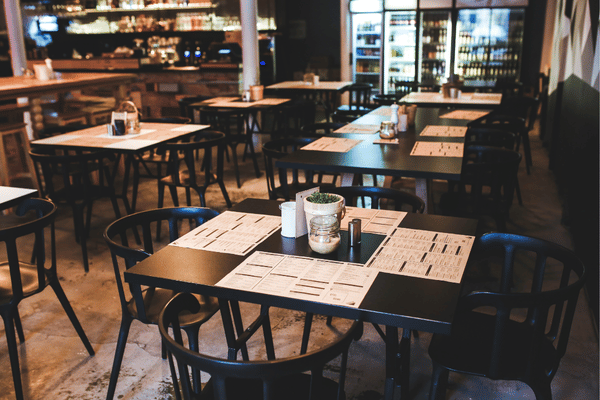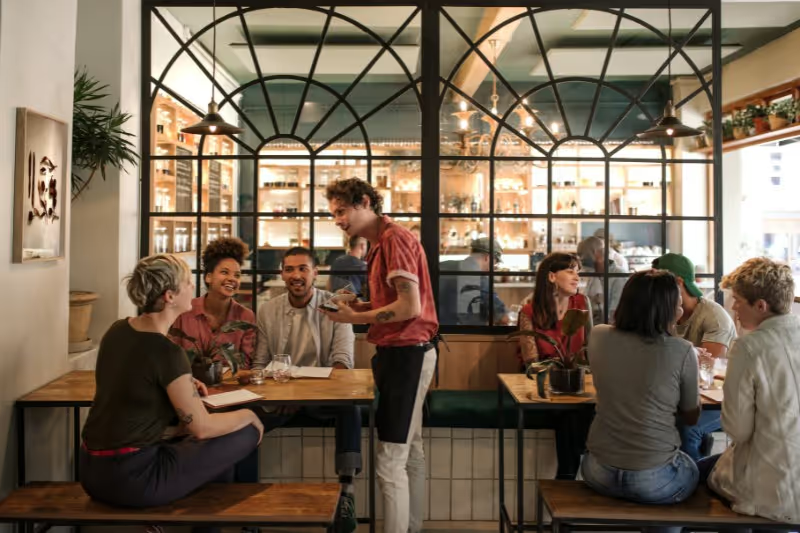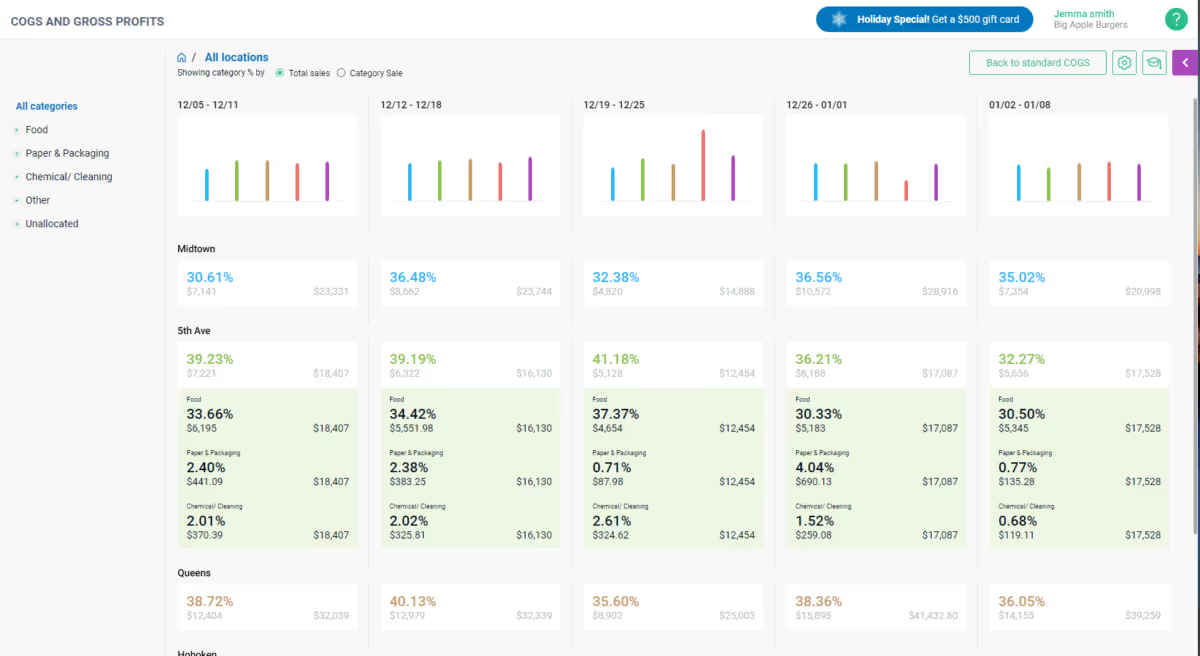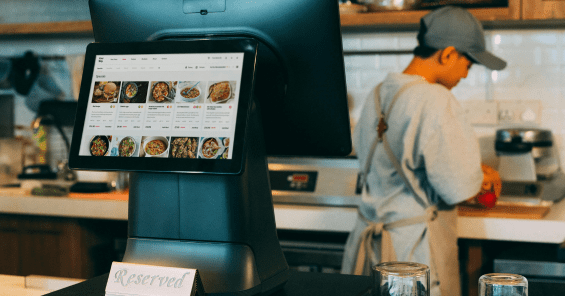

The Challenges of the Multi-Location Restaurant
Navigating the complexities of managing a multi-location restaurant? This comprehensive guide delves into the challenges and offers actionable strategies, focusing on the crucial role that Cost of Goods Sold (COGS) analysis plays in maximizing profitability and streamlining operations.
Anyone in the restaurant business knows managing a single restaurant comes with a spectrum of challenges and headaches these days. Going multi-location compounds the challenges.
Common obstacles to calm and easy-going multi-location restaurant management include:
Five Profit-Impacting Trends Shaping the Restaurant Industry in 2023
🔓 Unlock the secrets to restaurant success with actionable strategies for optimizing operations, maximizing profits, and building a loyal customer base.

- Ensuring consistency across all locations. Food quality, service, and overall customer experience are all more difficult in a multi-location. Customers expect a similar branded experience at each location, so a high level of consistency is a key necessity.
- Effective communication is critical when managing multiple locations. The lack of clear communication between management, staff, and vendors can lead to confusion, mistakes, and hinder profits.
- Managing operations across multiple locations is complicated. And time-consuming. Multi-location inventory management, purchasing, and vendor and supplier management are key ingredients to success. But each location may have different needs and requirements – especially when locations are geographically unique – which leads to more difficult management.
- Hiring, staffing, recruiting, and training teams at each location can be formidable in these days of extreme labor shortage. Locations may have additional unique staffing needs based on location, employment/hiring competition, local laws, and business volume.
- Technology is foundational to managing multiple locations effectively. Implementing a technology infrastructure (POS, Accounting, Website, Inventory Management, etc.) is now required for effective communication and management.
- Brand management, marketing, and advertising/promotion are difficult as the number of locations increases. Not only a larger required budget is a factor, but attention to marketing and advertising strategies, menu build and development, and overall restaurant messaging is key.

Not All Locations in a Multi-Location Business Are the Same
There are several common reasons why multi-location restaurant locations may be different. Let’s focus on the Cost of Goods (COGs). Typically, a multi-location restaurant’s Cost of Goods Sold (COGS) would be approximately 30%. But COGs may vary wildly between each location and over time at multi-location restaurants, based on things like:
- Supplier pricing: the cost of goods varies between locations depending on negotiated supplier and vendor pricing. Order volume, geographic location, ingredient requirements, and supplier relationships can all affect the pricing a restaurant negotiates with suppliers.
- Menu differences: multi-location restaurants may offer menu variations at each location based on local preferences, available ingredients, or the cost of ingredients.
- Operational differences: differences in operational efficiency and management and staff experience affect the cost of goods. For example, a location with experienced staff and more efficient processes may use fewer ingredients and produce less waste than a location with less experienced staff and less efficient processes.
- Regional pricing: regional differences also affect the cost of goods. For example, the cost of ingredients may be higher in some areas and affect the cost of goods sold.
COGS Analysis Over Time Is as Valuable as Location Comparison
In a multi-location environment, comparing locations is important. But equally important is comparing timeframes.
Comparing a restaurant's Cost of Goods Sold over time can provide actionable business intelligence into a restaurant's financial situation and overall efficiency.
Comparing COGS over time also identifies trends in a restaurant's ongoing financial efficiency. Say COGS is consistently increasing over time, it may indicate that the restaurant is not managing its inventory, menu builds, ingredient choices, vendor selection, or costs effectively.
By accurately analyzing COGS, owner/operators can identify where they can agilely reduce costs. Common cost reductions include negotiating better prices with suppliers, seasonal or local ingredient selections (which may have cyclical and predictable cost variances), or reducing food waste.
Also important is a restaurant’s management team to be able to compare a restaurant's COGS to industry benchmarks or similar restaurants. This provides useful analytics given how competitive foodservice can be.
Menu Engineering for Restaurant Profitability Relies on COGS Analysis
Menu engineering with an eye on profitability relies on COGS analysis. Good COGS insight can help a restaurant determine the profitability of individual menu ingredients and help better inform menu decisions that maintain or drive higher profits – without sacrificing customer satisfaction. If certain ingredients have an increasing COGS and low margins, owner/operators can remove or rework those ingredients on the menu.
Cost of goods sold analysis is an important tool that helps restaurants maintain or increase profitability as the ingredients in a menu item increase or decrease. Industry veterans know the importance of COGS intimately and use that data to make profit-enhancing decisions.
Through the calculation of the direct costs of the menu offering and its related profitability – by analyzing COGS – restaurants can better understand their costs and make more informed decisions about menu pricing, ingredient selection, menu engineering, vendor/supplier relationships, and inventory management.
Here are the most common ways that COGS insight can help restaurants engineer the menu to maintain or increase profitability:
- COGS data can help restaurants identify which menu items are most profitable. This information can be used to optimize the menu by removing low-margin items or coaching the wait staff on promoting higher-margin menu selections.
- Analysis of COGS can help restaurants set appropriate prices that generate a profit. By understanding the cost of each ingredient, restaurants can set prices that are competitive, attractive to customers, but always profitable.
- COGS analytics can help optimize inventory management. By effectively tracking the cost of ingredients – which may number in the thousands on some menus – and ensuring cost-effective suppliers are in place, waste and spoilage are reduced, and overstocking or understocking is avoided.
- Efficient COGS calculations help identify areas to reduce costs, such as by sourcing ingredients from more cost-effective suppliers or optimizing ingredient selections. Often this helps increase profitability without raising prices.
COGS data that’s accurate and reporting that can be performed quickly – without a steep learning curve – can help to maintain or increase profitability, even as the cost of ingredients fluctuates. As inflation has increased lately, this can assist foodservice businesses to quickly adapt to ingredient price increases and find replacement menu items or ingredients.
The Value of Cost of Goods Analysis to a Multi-Location Restaurant
The ability to efficiently and quickly calculate the cost of goods is crucial to the profitability of any foodservice business. And calculating COGS for a multi-location is even more important for:
- Controlling costs: accurate COGS analysis helps multi-location owner/operators identify exactly where costs are out of control and need to be reduced. Negotiating reduced pricing with suppliers or finding more efficient ways to build and prepare menu items are effective cost-control techniques driven by accurate COGS analysis.
- Inventory management: accurate calculations helps restaurants manage inventory levels. By tracking the usage of ingredients and supplies, managers can adjust their purchasing and ordering standard operating procedures to minimize waste and ensure they have sufficient inventory on hand to meet demand and customer satisfaction.
- Menu profitability: COGS analysis for each menu item allows restaurants to set prices that will cover their expenses while remaining competitive. If a restaurant sets prices too low, it may not cover its costs, leading to losses. If prices are set too high, it may deter customers from even visiting.
- Profitability analysis: by comparing the COGS for different locations and tracking each location's overall COGS over time, owners/operators can use this business intelligence to more accurately evaluate their profitability in real-time and make better decisions about their operations and strategies.
Calculating COGS is a key tool for modern multi-locations to manage costs, answer competitive forces, and increase profits.
Accurate (And Quick) COGS Analysis Deceases Costs, Increases Profits
Multi-locations need to pay attention to the cost of goods sold because it is one of the most important factors in determining profitability. COGS is a direct cost of doing business, and by closely tracking and managing COGS, restaurants can ensure that they are not spending too much on food and ingredients. This efficient budgeting helps add directly to the bottom line.
Cost of goods sold analysis and a careful comparison between each restaurant location decreases costs and increases profits by identifying cost-saving opportunities. By comparing the cost of goods across multiple locations, over time, a business can identify cost-saving opportunities such as purchasing supplies in bulk, negotiating better pricing with vendors, and streamlining processes in both front-of-house and back-of-house.
Additionally, by analyzing the cost of goods and examining inventory levels across multiple locations, a business can optimize its inventory management. For example, if a particular location has excess inventory, the business can easily redistribute it to other locations where there is demand.
COGS is also an important factor in reducing food waste and spoilage. Analyzing the cost of goods sold can help identify where waste and spoilage are occurring. If one location is producing more waste than others, managers can investigate and take the required steps to reduce it.

Improving each location’s efficiency is another value of detailed COGS analysis. By calculating the cost of goods and production processes across multiple locations, a restaurant business can identify areas where efficiency can be improved. Is one location taking longer to produce a product than others? The management can then investigate why and take steps to remedy any roadblocks to profitability.
Multi-Location Restaurant Strategies to Lower COGS
There are several ways that multi-location restaurants can save on the cost of goods sold and improve profitability:
1. Negotiate Better Prices with Suppliers
By negotiating better prices with suppliers, restaurants can reduce the cost of the food and ingredients they purchase.
Common ways that restaurants can negotiate better prices with suppliers include:
- Shop around and compare prices from different suppliers. By comparing important ingredient prices, you can determine which suppliers offer the best deals and negotiate with them for better prices.
- Build closer relationships with multiple suppliers. Recent supply chain issues since COVID-19 have proven this is a requirement for multi-locations. Establishing a good relationship with your suppliers can help you negotiate better prices. And through regular communication – and providing them with mutually-beneficial feedback – you can build trust and create a more profit-generating relationship.
- Negotiate in bulk. Purchasing larger quantities of ingredients where it makes sense can often result in better prices.
- Ask for additional discounts. Some suppliers may be willing to offer additional discounts or promotions to help you save on the cost of ingredients.
- Be willing to switch between suppliers as needed. If your current key supplier is not willing to offer better discounts or more competitive prices, consider switching to a new supplier. By switching to a new supplier, you may be able to negotiate better prices and save on the cost of ingredients. This also adds flexibility to your supply chain.
2. Reduce Food Waste and Spoilage
Food waste and spoilage are a significant part of the budget for multi-location restaurants, and reducing food waste can help save on COGS. By tracking and managing food waste, restaurants can reduce the amount of food thrown away and save money on ingredients.
Common methods in any restaurant to reduce food waste are:
- Plan and track food orders by carefully planning and tracking food orders. This may include forecasting the amount of food needed for each shift and regularly monitoring inventory levels to ensure that the right amount of food is ordered and used.
- Use inventory management software to help multi-locations compare and contrast each location and manage food waste in real time. This can provide valuable insights into where and how food waste is occurring, and help restaurants implement strategies to reduce food waste and save on COGS.
- Create policies and procedures to reduce food waste and ensure that all managers and staff are trained and aware of their duties in reducing food waste – and increasing profitability! Regularly monitoring and reporting on food waste levels with an application or back-of-house platform can make this easier on the management team’s schedule. Back-of-house software that is a labor saver and lessens management’s daily or weekly hours is typically cost-effective.
3. Implement Effective Portion Control Training and Monitoring
By closely training and monitoring employees on portion sizes, COGS can easily be reduced. Recent press about large national chains losing profits to unmanaged and unmonitored portion control has shown how important this is to the bottom line. These national chains lost millions through unchecked portions. By implementing effective portion control, restaurants can also reduce food costs and save on COGS.
MarketMan Can Help Cost-Effectively Lower GOGS for Multi-Location Restaurants
With MarketMan’s feature ‘COGS Over Time,’ multi-location restaurants can quickly measure each location and identify where managers can intervene to identify and then rectify issues that are driving up COGS.
The ‘COGS Over Time” report is a comparative dashboard view of COGS across multiple locations and multiple periods. Once set up, and with only a few clicks, you can easily drill down into each location’s COGS or even examine specific categories and items – and see how they trend over time and across locations.

This feature offers real business intelligence into COGS.
A real-world example is MarketMan customer The Other Bird, a hospitality group offering unique and charming culinary experiences. The Other Bird saved 10% on COGS using MarketMan’s inventory management platform.
Check out the quick interactive demo and learn how MarketMan can:
- Reduce COGS
- Easily Integrate with your POS
- Document and minimize food waste and spoilage
- Build profit-enhancing recipes to maximize margins
- Accelerate inventory counting, and
- Generate powerful reports to analyze profitability and actual vs theoretical usage

MarketMan's restaurant inventory management software simplifies back-of-house processes, from inventory management to food cost control. Automate daily tasks, reduce waste, and gain actionable insights to boost your restaurant's profitability. Take the guesswork out of operations and focus on delivering exceptional experiences. Book a demo now to see how MarketMan can transform your restaurant operations!
Author
Contributors
If you have any questions or need help, feel free to reach out
Don't miss out on maximizing your restaurant's profits! Calculate your ROI with MarketMan
Join over 18,000 restaurants and get the hottest restaurant tips delivered to your inbox
You may also be interested in
Ready to get started?
Talk to a restaurant expert today and learn how MarketMan can help your business






